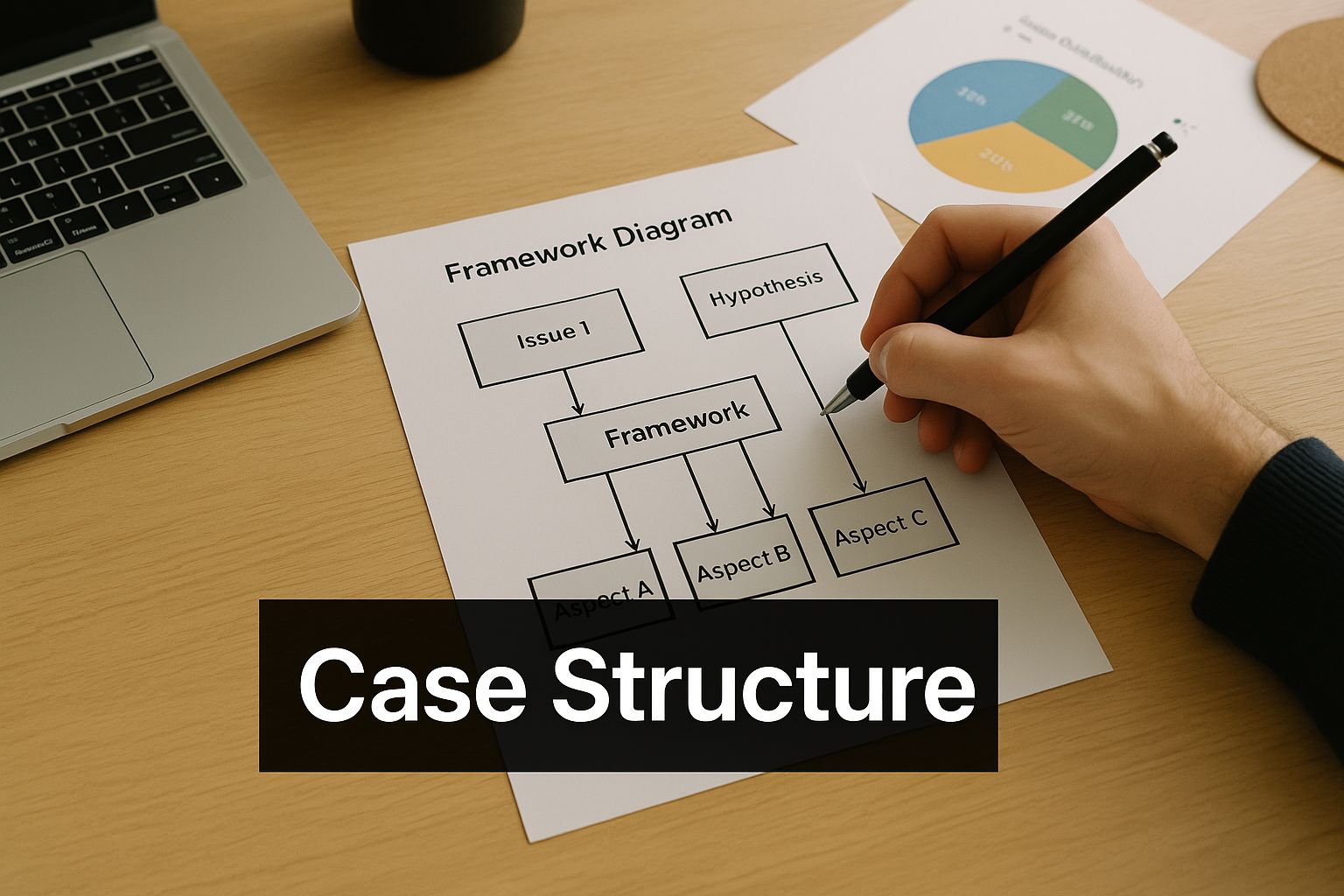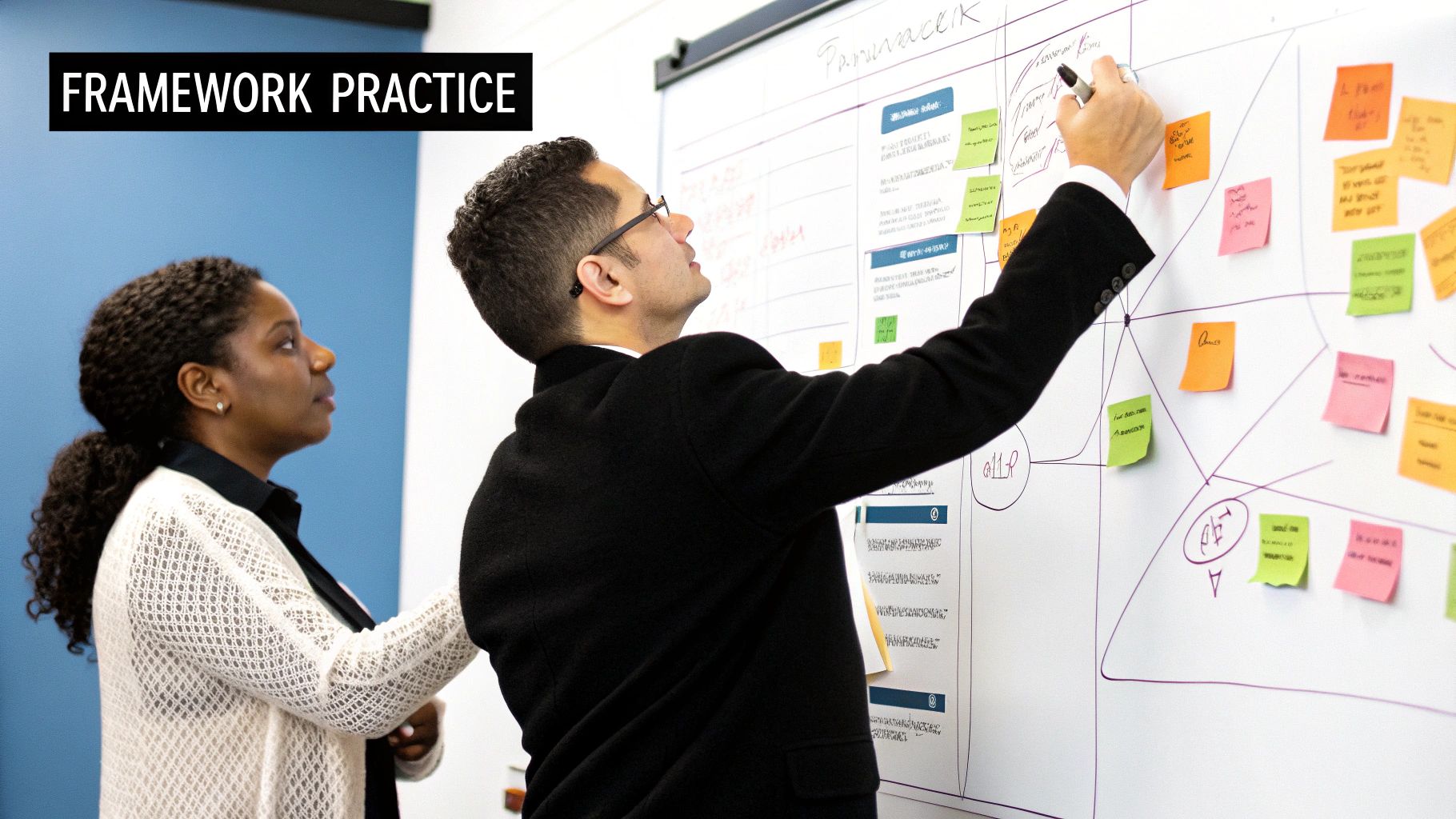How to Prepare for Case Study Interviews | Expert Tips to Succeed

Before you even think about memorizing a single framework, you need to get inside the recruiter's head. What are they really looking for when they throw a complex business problem your way?
A case interview isn't a test of knowledge. It's a live-action simulation of a consulting project, designed to see how you handle ambiguity and pressure. Top-tier firms like McKinsey, Bain, and BCG use this method to gauge whether you have the raw ingredients of a great consultant.
They aren’t hunting for one perfect answer. Instead, they're laser-focused on your thought process. This is your moment to show them how you break down a messy problem, think on your feet, and build a logical path toward a solution.
Core Competencies on Display
During the interview, the consultant across the table is mentally ticking boxes on a few key competencies. If you know what they are, you can tailor your preparation to hit every single one.
- Structured Problem-Solving: This is the big one. Can you take a vague, intimidating problem and break it into a clear, manageable structure? Your ability to create a logical roadmap is the single most important skill they’re looking for.
- Analytical Rigor: Get comfortable with numbers. You'll need to do quick calculations in your head, pull insights from charts, and make sound judgments based on data—all without reaching for a calculator.
- Business Acumen: Do you have a natural curiosity for what makes a business succeed or fail? They want to see that you can apply practical business sense to the scenario, moving beyond theory to what works in the real world.
- Communication and Poise: A brilliant idea is worthless if you can't communicate it effectively. Interviewers are watching to see if you can articulate your logic, summarize your findings, and present a recommendation with confidence.
The case interview is a performance. Recruiters are assessing your ability to act and think like a consultant in a real-time, client-facing simulation. The goal is to demonstrate your potential, not to prove you already know everything.
Getting this foundation right changes everything. It shifts your focus from just memorizing frameworks to actually developing a flexible, analytical mind.
To give you a clearer picture, here's a breakdown of what your preparation should be built upon.
Core Pillars of Case Interview Preparation
| Pillar | Objective | Key Action |
|---|---|---|
| Understanding the "Why" | Grasp the core skills recruiters are evaluating. | Focus on demonstrating your process, not just finding the right answer. |
| Framework Fluency | Learn to apply, not just recite, analytical structures. | Practice adapting frameworks like Porter's Five Forces to unique case scenarios. |
| Quantitative Skills | Build speed and accuracy in mental math and data interpretation. | Run daily drills on calculations involving percentages, growth rates, and profits. |
| Communication & Synthesis | Articulate your thought process clearly and concisely. | Practice summarizing your findings and delivering a strong, data-backed final recommendation. |
Nailing these pillars will give you the confidence and competence to handle whatever the interviewer throws at you.
For more in-depth articles and expert advice to guide your practice, the BuddyPro Blog for Case Interview Insights is a great resource to explore.
Building Your Analytical Toolkit: Frameworks and Mental Math

Walking into a case interview without a solid analytical toolkit is like trying to build a house with just a hammer. You might get somewhere, but it won't be pretty. Success hinges on having a flexible set of tools you can adapt to any business problem thrown your way.
The goal isn't to memorize dozens of formulas. It's to internalize a way of thinking. This toolkit really comes down to two core components: analytical frameworks and quantitative agility. Think of frameworks as the blueprint for deconstructing a problem, while your mental math skills are the engine that drives the analysis. You absolutely need both to succeed.
Frameworks Are a Starting Point, Not a Script
Here’s where so many candidates go wrong: they treat frameworks like a rigid script. They hear the word "profitability" and immediately start reciting a formula they learned from a book. This is a huge red flag for interviewers. It signals you can't think for yourself or adapt to the unique details of the case.
The real skill is understanding the logic behind different frameworks and then building a custom one on the spot. To get there, you need to master various structured problem-solving approaches that teach you how to systematically break down messy challenges into clean, manageable pieces.
Your structure needs to be MECE (Mutually Exclusive, Collectively Exhaustive). It’s a simple but powerful principle that ensures you’ve covered all your bases without anything overlapping. For example, if you're dissecting a drop in revenue, a MECE approach might be:
- Internal Factors: Things the company can actually control (e.g., pricing strategy, product quality, sales team performance).
- External Factors: Forces out in the market (e.g., a new competitor, shifting consumer trends, an economic downturn).
This kind of simple, bespoke structure is almost always more effective than a generic one because it's built specifically for the problem in front of you.
The best candidates don't just use frameworks; they build them. They listen to the prompt, pinpoint the core issue, and then create a logical, tailored structure to guide their entire analysis.
Sharpening Your Quantitative Edge
Quick, accurate mental math is non-negotiable. You won’t have a calculator, and your ability to crunch numbers under pressure is what allows you to turn data into meaningful insights. It shows you have real analytical horsepower and keeps the conversation moving forward.
There's no shortcut here—you just have to practice. Focus your drills on the types of calculations that pop up in almost every case.
Essential Mental Math Drills:
- Market Sizing: Get good at breaking down huge numbers. Try to estimate the number of pizzas sold in your city each week. You'll have to think through the population, how many people eat pizza, how often, and how many slices they eat. It's all about logical assumptions.
- Profitability Analysis: You need to be able to calculate revenue, costs, and profit margins in your head. Practice calculating percentage changes and growth rates until they feel like second nature.
- Breakeven Point: Master the formula for this (Fixed Costs / (Price - Variable Cost)). More importantly, understand when to use it, like figuring out if a new product launch is even viable.
Having a few key stats in your back pocket also adds a layer of credibility. A good consultant has a general sense of the world. Knowing the approximate US population (~320 million) or world population (~8 billion) allows you to make reasonable assumptions without having to ask for every single data point. It projects confidence and shows you've done your homework.
Ultimately, your toolkit is all about developing flexibility and speed. When you can combine adaptable frameworks with sharp quantitative skills, you’ll be ready to handle whatever case they throw at you.
How to Structure Your Prep Timeline for Maximum Impact
Showing up sharp and confident for a case interview isn't about last-minute cramming. It's the result of smart, consistent practice. The secret is having a strategic playbook for your preparation, whether you have a full six months or just two intense weeks to get ready.
History shows a clear link between early preparation and success in consulting recruitment. Many top-tier programs suggest candidates start prepping up to six months before their interview. A typical schedule involves one or two mock interviews per week, layered with daily mental math drills and framework practice. It’s a proven formula.
For instance, U.S. undergrads often need to get going by April for the peak recruiting season in July, while international candidates might start in June for October deadlines. You can find more detailed timelines for different career paths over at Management Consulted.
The Long-Term Approach: Six Months to Success
Having a long runway is the ideal scenario. It lets you build a deep, solid foundation of skills without burning out. With several months on your side, you can layer your learning, moving methodically from theory to hands-on application.
Here’s what a six-month plan could look like:
- Months 1-2: Focus on the Fundamentals. This is your time to absorb the basics. Get your hands on case books, make sure you understand core business concepts, and start doing daily mental math drills. The goal here is mastering the building blocks, not speed.
- Months 3-4: Dive into Live Practice. It's time to start doing one or two live mock interviews a week. Your focus should be on applying frameworks in real-time, structuring your thoughts out loud, and just getting comfortable with the interview format.
- Months 5-6: Refine and Specialize. By now, general cases should feel familiar. Use this period to drill down into specific case types (like M&A or market entry) and polish your communication and delivery. This is also a great time for peer-led drills to iron out any specific weak spots.
An extended timeline like this gives you the space to develop genuine business intuition—something you simply can't fake. You'll have time to follow industries, understand market trends, and connect what you’ve learned in the classroom to real-world business challenges.
The Accelerated Plan: Two Weeks of High-Intensity Prep
Sometimes, a great opportunity just drops into your lap without much warning. While it's not the ideal situation, a two-week sprint can still be incredibly effective if you’re disciplined and strategic. This timeline is all about ruthless prioritization and immersive practice.
An accelerated timeline demands focus. You don't have time to learn everything, so concentrate on mastering the 80% of skills that will solve 80% of the cases. This means a heavy emphasis on profitability, market sizing, and clear, structured communication.
Your two-week schedule will be intense:
- Days 1-3: Framework Immersion. Dedicate these first few days to truly understanding the logic behind profitability, market sizing, and business situation frameworks. Your goal is to internalize why they work, not just memorize a checklist of steps.
- Days 4-10: The Mock Interview Gauntlet. This is the heart of your prep. Aim for one to two mock interviews every single day. This high volume is crucial for recognizing patterns and building muscle memory for performing under pressure.
- Days 11-14: Review and Polish. Start tapering down the number of full cases. Spend these last few days reviewing your notes, re-doing specific math drills where you struggled, and practicing your opening and closing statements until they’re second nature.
In this high-stakes scenario, finding reliable practice partners is non-negotiable. Hit up your university's career services, join consulting clubs, or use online platforms to connect with peers who are also in a time crunch.
The image below highlights the central role of structuring your approach—a critical piece of any preparation timeline.

A strong case structure is the backbone of your analysis. It provides a clear roadmap for both you and the interviewer, keeping your thinking organized and logical.
No matter your timeline, it's worth seeing how these two approaches stack up. Each path requires a different mindset and a different allocation of your time and energy.
Sample Case Interview Preparation Timelines
| Activity | Standard Timeline (6 Months) | Accelerated Timeline (2 Weeks) |
|---|---|---|
| Foundational Learning | Months 1-2: Deep dive into case books, business concepts, and daily math drills. | Days 1-3: Rapid immersion in core frameworks (profitability, market sizing). Focus on logic. |
| Mock Interview Cadence | Months 3-6: 1-2 mock interviews per week, gradually increasing difficulty. | Days 4-10: High-intensity practice with 1-2 mock interviews per day. |
| Skill Focus | Broad skill development, including specialized case types (M&A, PE) and industry deep dives. | Laser focus on the most common case types. Prioritize structured communication and speed. |
| Review & Refinement | Months 5-6: Dedicated time to polish delivery, work on weak spots, and conduct peer drills. | Days 11-14: Review past cases, re-do challenging math, and perfect opening/closing statements. |
| Overall Goal | Build deep business intuition and comprehensive case-solving skills. | Develop strong pattern recognition and muscle memory for core case types under pressure. |
Ultimately, choosing a timeline is about being realistic with the time you have and committing fully to the process.
Quality Over Quantity: Finding Partners and Giving Feedback
Regardless of your timeline, remember this: the quality of your practice sessions is far more important than the raw number of cases you churn through. A poorly run mock interview with zero feedback is just a wasted hour.
Your goal is to find partners who are just as committed as you are. A great practice partner will:
- Give you honest, constructive feedback on both your structure and your communication style.
- Push you to defend your assumptions and clarify your logic when things get fuzzy.
- Accurately simulate the pressure and pace of a real interview.
When it's your turn to give feedback, be specific. Instead of saying, "Your structure was confusing," try something like, "Your structure for analyzing costs was a good start, but you didn't initially separate fixed and variable costs, which made the rest of the analysis harder to follow." This is the kind of detail that actually helps people improve.
In the end, your timeline is a guide, not a rigid set of rules. The most important thing is to be consistent, deliberate, and focused on learning something new from every single practice case you do.
Crafting Your Narrative and Communicating with Confidence

Here's a truth every aspiring consultant learns, sometimes the hard way: a brilliant analysis is completely worthless if you can't communicate it. How you tell the story of your analysis is just as crucial as the analysis itself. This is the moment you stop being a number-cruncher and start acting like a trusted advisor.
A case interview isn't some silent, high-stakes quiz where you scribble away and reveal a single perfect answer at the end. Think of it as a collaborative work session. Your interviewer needs to hear your thought process, see how you pivot with new information, and understand the logic guiding your decisions. Thinking out loud is the only way to give them a window into your mind.
The Art of Thinking Aloud
Let’s be clear: thinking out loud is a skill, and like any skill, it takes practice. Unstructured rambling can be just as damaging as dead silence. The real goal is to narrate your problem-solving journey in a way that’s clear, logical, and easy to follow.
A great place to start is by verbalizing your initial structure. Once the interviewer lays out the case, take a moment to build your roadmap.
You might say something like, "Okay, to get to the bottom of this profit decline, I'd like to investigate three core areas. First, I'll dig into revenues, then I'll look at the cost side, and finally, I'll examine broader market trends. Does that sound like a reasonable starting point?"
This simple opening move does a few powerful things all at once:
- It shows you’re structured. You've immediately established a logical plan of attack.
- It invites collaboration. The interviewer can now easily agree or nudge you toward a different area of focus.
- It gives you a safety net. If you get stuck down one path, you can always circle back to your original structure.
From that point on, keep up the narration. Crunching numbers? Do the math out loud. Interpreting a chart? Explain what you see and, more importantly, what it means for the problem you’re trying to solve. This simple shift turns a tense test into a productive, two-way conversation.
Creating a Powerful Opening Structure
Your initial structure is the foundation for everything that follows. A strong, tailored opening sets a confident tone for the entire case and shows you can handle ambiguity with a clear plan. A weak or generic opening, on the other hand, puts you on the defensive right from the start.
So, resist the urge to just spit back a memorized framework. Listen intently to the prompt and build a custom structure that fits the specific problem. For instance, if a company wants to launch an electric scooter in a saturated market, a generic "market entry" framework is fine, but a tailored one is far better.
Here's what a more tailored structure might look like:
- Market Opportunity Assessment: First, how big is this market, really? What's its growth potential? And who are the specific customer segments we should be going after?
- Competitive Landscape Analysis: Next, who are the big players already on the field? What are their core strengths and weaknesses? How are they likely to react when we show up?
- Our Company's Capabilities: Then, let's look inward. Do we actually have the tech, supply chain, and brand power to win? What makes our scooter uniquely valuable?
- Go-to-Market Strategy: Finally, how do we make this happen? This covers pricing, distribution, marketing, and the key financial projections.
This custom approach is specific, logical, and proves you’re actively wrestling with the problem, not just grabbing a pre-made tool from your mental toolbox.
Your job isn't to have all the answers. It's to have a great process for finding them. Communicating that process clearly is how you prove your value.
Synthesizing and Delivering a Compelling Conclusion
The final recommendation is your grand finale. This is where you weave all your analysis together into a single, cohesive, and actionable answer. A great conclusion isn't just a summary of what you did—it's a persuasive pitch for a specific course of action.
Your recommendation needs to be sharp and definitive. Lead with your main point upfront, then immediately back it up with your key findings.
A rock-solid closing follows this structure:
- The Recommendation: Start with a direct, unambiguous statement. "I recommend that the company launch the new electric scooter in the target city."
- Supporting Arguments: Follow up with the 2-3 most critical reasons that support your conclusion, pulling directly from the data you analyzed. "This is because the market is large and growing, our product has a key technological advantage, and we can achieve profitability within 18 months."
- Acknowledge Risks: Briefly touch on potential risks and how you might mitigate them. This demonstrates balanced, strategic thinking. "Key risks include intense price competition and potential regulatory hurdles, which we can address by..."
- Next Steps: Propose a couple of immediate next steps to show you’re forward-thinking and action-oriented. "As a next step, I would suggest conducting a small-scale pilot program to validate our demand assumptions."
This structure projects confidence and a practical mindset. The power of this communication style is well-documented; candidates who run through at least 20 to 30 practice cases consistently report higher confidence and pass rates. This is largely because they've honed their ability to communicate, not just memorize frameworks. You can find more on how practice refines this skill on StrategyU.
Ultimately, mastering your narrative is what transforms the interview from an interrogation into a showcase of your future potential as a consultant.
Navigating Different Case Types and Common Pitfalls
Not all cases are created equal. One day you might be asked to size the market for electric scooters in Berlin, and the next you’re advising a pharmaceutical giant on a potential merger. Your ability to adapt is what separates a good candidate from a great one.
While frameworks give you a solid starting point, true mastery comes from recognizing the unique demands of each scenario. The questions you ask for a profitability case are fundamentally different from those in a market entry case. Knowing how and when to pivot is everything.
Recognizing the Major Case Archetypes
Most case interviews you'll encounter fall into a few broad categories. Get familiar with these archetypes, and you'll start to build mental models for tackling them. This isn't about memorizing scripts—it's about understanding the core business problem you're being asked to solve.
Here are the most common scenarios you’ll likely see:
- Profitability: The classic "profits are down, why?" case. Your job is to play detective, dissecting revenues and costs to find the root cause. Is it a pricing issue, a drop in volume, or are costs spiraling out of control?
- Market Entry: This case asks whether a client should enter a new market or launch a new product. You'll need to assess the market size, competitive landscape, and the client's own capabilities to determine if the move makes strategic and financial sense.
- Mergers & Acquisitions (M&A): Here, you'll evaluate whether one company should buy another. This involves a deep dive into potential synergies, cultural fit, and the risks involved to justify the hefty price tag.
- Pricing Strategy: This focuses on setting the optimal price for a new product or adjusting an existing one. You'll need to think through cost-based, competitor-based, and value-based pricing models to land on the right number.
By identifying the case type early, you can deploy the right analytical tools from the start, making your entire approach more efficient and targeted.
Sidestepping Common Interview Traps
It’s not enough to just know the case types. You have to be ready for the common pitfalls that can derail even the most prepared candidates. Interviewers don't just want to see you solve a problem; they want to see how you handle pressure when things go wrong.
One of the biggest mistakes is falling into an analytical rabbit hole. This happens when you get fixated on a minor detail and burn precious time on an analysis that doesn't really move the needle. Think spending ten minutes calculating the exact number of red cars in a city when a rough estimate would have been perfectly fine for a market sizing question.
Another classic trap is the math mistake. It happens to everyone, even seasoned consultants. The key isn't whether you make one—it's how you recover. If you realize your calculation is off, don't panic or try to brush it under the rug.
"A math error is a test of your professional maturity. The best response is to calmly acknowledge it, correct it, and explain how it impacts your analysis. This shows composure and integrity—two critical consulting traits."
Simply say, "My apologies, let me recalculate that. It looks like the actual profit margin is closer to 15%, not 25%. This makes the unit economics less attractive and shifts my thinking." That calm course correction is far more impressive than pretending the mistake never happened.
Pivoting When You Get Stuck
We’ve all been there—that dreaded feeling when you’ve hit a dead end and your initial hypothesis is clearly wrong. This isn't a failure; it's a feature of the case interview process. The interviewer wants to see if you can pivot gracefully when the data throws you a curveball.
If you find yourself stuck, just take a breath. Pause and look back at your initial structure. You could say something like, "Interesting. The data doesn't seem to support my initial idea that the issue is on the revenue side. I'd like to pivot and explore the cost structure now, specifically looking at their variable costs."
Here’s a quick playbook for an effective pivot:
- Acknowledge the Dead End: State clearly that your current path isn't working.
- Refer to Your Structure: Use your framework as a map to find a new direction.
- Formulate a New Hypothesis: Propose a new line of questioning based on what you've learned.
- Check In with the Interviewer: A quick, "Does that sound like a reasonable next step?" keeps them engaged and on board.
Successfully navigating these challenges builds resilience. By preparing for different case types and anticipating these common pitfalls, you develop the agility to stay calm, confident, and in control—no matter what problem you're asked to solve.
Your Top Case Interview Prep Questions, Answered
https://www.youtube.com/embed/LCWr-TJrc0k
Even when you have a solid prep plan, a few nagging questions always seem to surface. Getting clear answers to these common hurdles can help you focus your energy where it actually counts and walk into your interview with real confidence. Let's dig into the questions I hear most often from candidates.
So, How Many Practice Cases Do I Really Need to Do?
Everyone wants a magic number, but the honest answer is it depends. That said, a good target for most successful candidates is somewhere in the 20 to 40 range.
The most important thing to remember is that it's all about quality over quantity. I've seen candidates who've rushed through 50 cases and learned very little, while others who deeply analyzed just 20 were far more prepared.
After every single practice case, you need to sit down with your partner and debrief. What went well? Where did you stumble? What specific feedback can you implement next time? That reflection is where the real growth happens. The goal isn't just to survive a case, but to refine your problem-solving toolkit with each one.
Where Can I Find Good Practice Cases and Prep Materials?
Your first stop should always be the source. Top firms like McKinsey, BCG, and Bain all publish free case studies right on their websites. These are the gold standard because they show you exactly what those firms value.
University consulting clubs are another fantastic resource, often with extensive casebooks and, most importantly, a pool of people just as motivated as you are to practice. If you've exhausted those, there are paid platforms that offer huge libraries of cases and drills for more targeted practice.
A quick word on classic books like "Case in Point": they're a great starting point, but don't treat their frameworks like a rigid script. The best candidates learn the principles and then build a custom structure that fits the unique problem in front of them.
A mix of these resources will give you a much more robust and well-rounded prep experience.
How Do I Build Business Acumen Without a Business Degree?
You absolutely don't need a business degree to develop sharp business intuition. It really just comes down to consistent exposure and active thinking.
Start by making it a daily habit to read publications like The Wall Street Journal, The Economist, or the Financial Times. This isn't just about skimming headlines; you need to engage with the material. For more ideas on building these skills, check out our other professional growth tips on the Parakeet AI Blog.
When you read about a company launching a new product or making an acquisition, treat it like a mini-case study. Ask yourself:
- Why are they really doing this? What’s the strategic goal?
- What could go wrong here? What are the biggest risks?
- How will their main competitors likely react to this move?
Try to focus on a couple of industries that you genuinely find interesting. This will help you build the kind of deep, contextual knowledge that really impresses interviewers. It's that active curiosity they're looking for.
Any Tips for Managing Nerves on Interview Day?
On the day of the interview, the battle is won or lost in your mindset and routine, not in last-minute cramming. Frantically flipping through your notes right before you walk in is a surefire way to spike your anxiety.
Instead, focus on getting your brain warmed up and your body calm. Some people like to do a few simple mental math problems to get their analytical mind firing. Get a full night's sleep—it’s non-negotiable. Eat a solid breakfast.
Just before you head in, take a few moments for yourself. Close your eyes and take several slow, deep breaths. This small action can do wonders to center you and calm your nervous system. Walk in with an attitude of genuine curiosity. You're not there to be interrogated; you're there to collaborate on an interesting problem with a smart person. Remember, they want to see you succeed.
Feeling prepared is the ultimate antidote to nerves. With ParakeetAI, you get a real-time interview assistant that provides instant, tailored answers, helping you walk into any conversation with confidence. Ready to ace your next interview? Visit https://www.parakeet-ai.com to get started.




